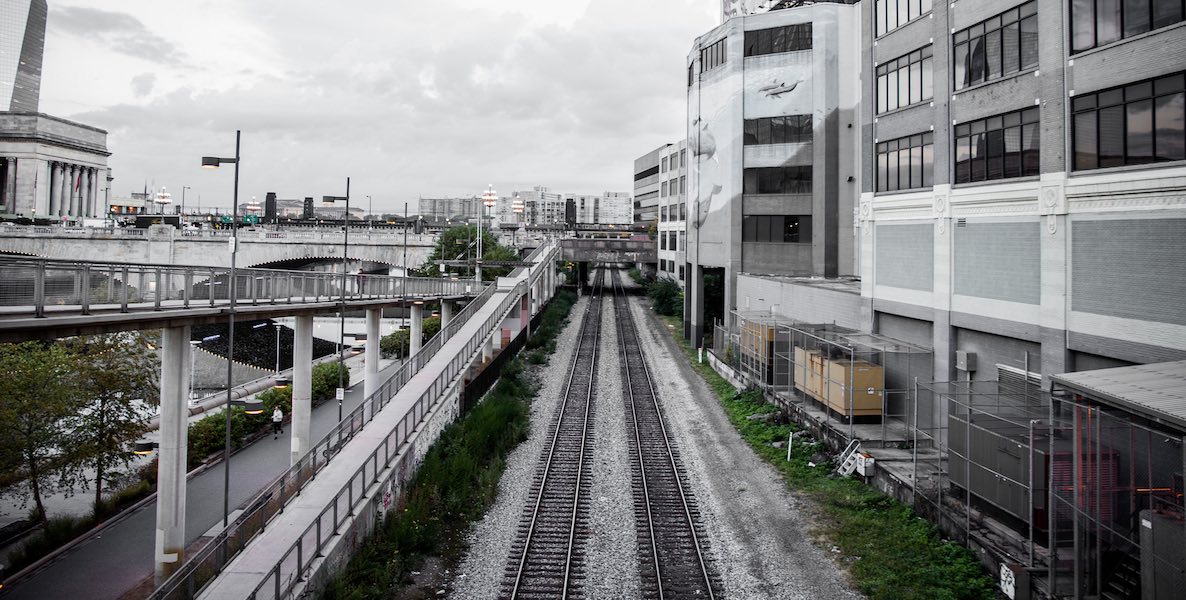Infrastructure was a persistent theme of Donald Trump’s campaign. He claimed, with some justification, that America’s roads, bridges, ports, waterways and airports were no longer first rate. And he promised to invest a trillion dollars into infrastructure—twice as much as Hillary Clinton proposed. But the difference in their plans was not so much the amount, but how resources were to be delivered, including the role of government versus the private sector.
If there is a policy around which American cities might find common purpose with Trump, it’s likely infrastructure spending. As physical and demographic hubs of the economy, large metropolitan city centers are the most significant customers for infrastructure spending.
Infrastructure refers to the physical assets that move and connect people and goods, as well as the basic utilities of modern social life: Water (including water and sewage treatment), energy, and communications. A broader definition of infrastructure refers to all public capital assets such as schools, government buildings, parks, libraries, and other public facilities.
Here are a few facts about U.S. infrastructure to set the context:
First, most infrastructure spending is local and state, not federal. There are about 3 dollars of local and state infrastructure investments for every dollar of federal investment. A great deal of local and state capital comes from the bond market. Thus, states and cities that are already overloaded with debt, or that have poor credit ratings, are at a disadvantage as it relates to capital capacity and cost.
Second, present infrastructure spending is fully inadequate. The amount of infrastructure spending as a percentage of gross domestic product has declined over the past few decades even as the average age of American infrastructure has risen. The U.S. was a leader in infrastructure quality and investment in the middle of the 20th Century when it invested heavily in new highways, bridges, dams and the electrical grid. Our status as a leader has declined as the useful life of investments from 50 years ago have eroded.
Third, the present capital need is significant. The American Society of Civil Engineers 2013 infrastructure report gave the nation a cumulative grade of D+; the next report will come out in 2017. Read the report; it is not a policy prescription but a simple exposition of facts. It estimates that we will need an investment of well over $3 trillion by 2020 to fill the gap.
Fourth, private capital can play an important role. We are still in a period of historically low interest rates, although that may end now that the Federal Reserve has begun raising rates. Still, an infrastructure strategy launched today or in the near future will cost less than in a higher interest rate period that may exist in 2018 and beyond. We will likely look back over the past decade of low interest rates and ask why we borrowed so little to upgrade infrastructure, given its productive value.
The first priority of an infrastructure inventory are projects that protect public safety. While it is rare, bridges do collapse. And water infrastructure, in many older cities with limited taxing capacity, are no longer safe for consumption. Flint got the most attention but there are scores of municipalities with the same problem.
This is also a period of global liquidity, which means there is plenty of capital looking for high quality projects. If there are tax reductions in corporate and personal income as Trump promises, liquidity will increase. If tax policies incentivize foreign capital repatriation, that will also contribute to domestic capital flows that could be used for infrastructure investments.
Fifth, infrastructure spending sparks bipartisan interest. The disagreements will be on the amount, the delivery mechanisms, and its impact on the federal budget. The politics around the federal budget may become the major issue in the infrastructure debate. Some Democrats who were all in during the Obama stimulus could become deficit hawks during infrastructure debates. If the infrastructure bill arrives within the context of significant cuts in social programs, the battle lines will be harsh. It is hard to predict the Republican response since they are wary of increasing the deficit but in the right political context—George Bush’s Medicare plan comes to mind—they are fully capable of becoming big government conservatives. And they hold most of the legislative cards.
A Trump infrastructure bill could either be his easiest policy win or it could flounder in the midst of a larger battle regarding spending and the federal deficit. Moreover, if the plan travels through the tax code, there will be battles over existing tax credits as part of the offset for infrastructure credits.
President-elect Trump is a real estate guy who sees infrastructure through the lens of large-scale construction projects, where the government makes it easier for private capital to enter otherwise riskier deals. Indeed, private investors have become dominant players in infrastructure investing especially outside the United States, through specialized infrastructure funds, pension funds, and sovereign wealth funds.
So-called public-private partnerships (P3s in policy lingo) are increasingly common in re-building highways and other physical assets. The National Council for Public-Private Partnerships has been an active promoter of P3 policies since the mid-1980’s. Governing magazine recently wrote about the extent and variety of public-private infrastructure investments in the United States.
While the Trump strategy has not been announced or finalized, a pre-election paper by Peter Navarro, a business professor from University of California-Irvine, and Wilbur Ross, the private equity billionaire Trump nominated for Commerce Secretary, spells out the general direction. The paper proposes a tax credit of 82 percent for the equity portion of an infrastructure project taken on by a private investor. Trump proponents think it will be revenue neutral due to multipliers that enlarge the tax base. They also say it will avoid the cost and bureaucracy of a new federal program such as the infrastructure bank proposed by Clinton and others.
The plan is filled with potential pitfalls, outlined in a variety of media and policy outlets. The most important critique is that private investments will only work for projects that generate fees or tolls and hence limit the variety of infrastructure investments required. Moreover, depending on how the regulations for the tax credits are written, it may not distinguish between projects that need the tax credit versus those for which the credit simply increases returns and diminishes risk.
I think there will be a major infrastructure bill but a hybrid of the one Trump is pursuing and Democrats are promoting: Part tax credit and credit enhancements (as with Build America Bonds), and part direct grants. It is also possible that the amount shrinks in size against a host of competing budget and tax priorities.
No matter how the infrastructure plan is structured, the cities and states that profit the most will do so because they are well-prepared. Ultimately the capital or credits flow to states, localities, and a variety of market and civic participants. And depending on the way the federal regulations are written, states and localities will have some discretion on allocation strategies.
That is where local vision and strategy really matter. Being prepared to take the most advantage of an infrastructure bill means compiling a smart inventory of projects, utilizing environmental intelligence, and rethinking how we manage public assets.
The Inventory: The first priority of an inventory are projects that protect public safety. While it is rare, bridges do collapse. And water infrastructure, in many older cities with limited taxing capacity, are no longer safe for consumption. Flint got the most attention but there are scores of municipalities with the same problem.
Of course, a city like Flint already has among the highest water bills in the nation and has no additional taxing capacity. It needs new piping and treatment capacity without additional cost to ratepayers.
A second priority of an inventory are projects with high multiplier values based on an economic competitiveness strategy. Look at a city like Philadelphia and ask what the major transformation investments in infrastructure would be: Re-claiming vast tracts of environmentally damaged land along the Delaware from the Navy Yard to the far northeastern end of the city; linking Center City and the university and research complex in West Philadelphia by traversing the rail yards, upgrading and expanding mass transit, expanding the airport?
Cities need to be able to come together and debate transformative investments based on both vision and facts. Here the burden is really civic. Some localities are better positioned than others to have change conversations.
What if major investments into Pennsylvania’s highway system, Philadelphia’s airport, or the city’s regional transportation system are in the works? Does anyone think that the state’s Turnpike Commission, the region’s transportation authority, or the city’s airport authority are up to high quality management? They are all filled with political appointees that lack the capacity or incentive to deliver high quality public goods.
Of course, all inventory projects must demonstrate that they couldn’t come to fruition without the new tax credits or capital allocations. As I noted, that is one of the biggest potential downsides of the present Trump strategy; it makes no distinctions around either capital capacity or economic value. It assumes that investor and construction industry priorities will deliver those answers. It’s a dubious assumption.
Environmental Intelligence: We have had a revolution in design, technology, and civil engineering focused on sustainable infrastructure. This has to do with the full spectrum of project issues: How projects are sited and designed; the use of green building materials; built in systems to reduce and recycle energy; and high tech sensor technologies that manage everything from highway traffic flows to the absorption of stormwater and even agricultural runoff.
To undertake a major infrastructure investment program without recognizing the opportunity to vastly improve environmental health would be silly. Put aside the Trump issues regarding climate change and his interest in deregulation, particularly as it relates to the Environmental Protection Agency. At local and state levels environmental strategies can still be elevated as smarter ways to build that will reduce operating costs over the life of the projects. The constituency for this kind of stewardship exists and cuts across political party, social geography, and social class.
Public Management: New periods of infrastructure investment, particularly ones aided by major technological shifts, should provide an opportunity to rethink the social organization of public asset management. Policy is about long term management strategy more than the transaction that appropriates, regulates or helps to build something.
So what if major investments into Pennsylvania’s highway system, Philadelphia’s airport, or the city’s regional transportation system are in the works? Does anyone think that the state’s Turnpike Commission, the region’s transportation authority, or the city’s airport authority are up to high quality management? They are all filled with political appointees that lack the capacity or incentive to deliver high quality public goods. The answer does not have to be privatization but it could be that we can move to a more disciplined approach to asset management that is protected from cronyism and is more accountable to its citizen customers.
In a prior column I recommended Detter and Folster’s The Public Wealth of Nations, a smart read that pulls data and management strategies from throughout the globe in order to argue for ways we can add value to public assets and hence increase economic growth. Infrastructure investments offer an opportunity to rethink our models of governance. Building 21st Century systems and managing them through mid-20th Century industrial governance models will diminish their value and potential.
Whatever bill comes out of Washington to support urban infrastructure will be just the start. The real action will happen through the public and private sector networks that have the capacity to plan, implement, and innovate.
Header photo by Terry Robinson on Flickr





